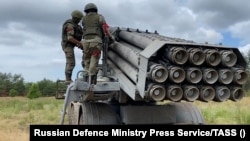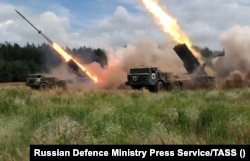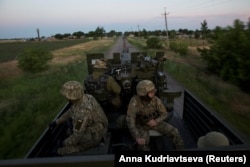Ever since Moscow's full-scale invasion of Ukraine in February, the war has been an uneven fight of sweeping breakthroughs, tactical withdrawals, and grinding attrition that has made progress in the conflict difficult to gauge.
In a recent sign of this, Kyiv won a symbolic and strategic victory on June 30 when Russian forces withdrew from Snake Island in the Black Sea less than a week after its own forces pulled back from heavy shelling and a Russian advance on the city of Syevyerodonetsk in Ukraine's eastern Donbas region.
Russian forces are continuing to press forward with their aims of capturing more of the Luhansk and Donetsk provinces and now have their sights on Lysychansk, the sister city of Syevyerodonetsk, where Ukrainian troops once again find themselves under fire from a devastating Russian artillery barrage.
Meanwhile, Ukrainian forces have made several counterattacks in the country's south and made new territorial gains.
To find out more about how to measure the pace of the war and how Russian and Ukrainian forces compare, RFE/RL spoke with Dara Massicot, a senior researcher at the U.S.-based RAND think tank and a former senior analyst at the Pentagon, where she focused on the Russian military's capabilities.
RFE/RL: In recent weeks, we've seen a far slower moving and grinding war in Ukraine, especially in the Donbas. In your view, is it possible to tell who is winning a war like this and, if yes, what are some of the key indicators to watch?
Dara Massicot: You're correct. We are seeing a slower, more deliberate Russian approach featuring a lot of artillery strikes, followed by incremental movements behind them.
In the weeks ahead, I would be watching out for controlled departures, [such as] from the Ukrainian side, like we've seen in Syevyerodonetsk and will likely see in other areas [nearby]. Sometimes things stall in particular areas for a few weeks or a few months and then progress can be quite rapid. So it's not necessarily a linear fight happening.
RFE/RL: Obviously, it's difficult to say who's winning the war, but is there anything else to keep an eye on?
Massicot: I listen to the words of the Ukrainian military themselves, and they're saying that they are outgunned by a significant margin, particularly in terms of artillery strikes. Russian [forces] have numbers, both in terms of quantity and the range that they can apply against them, and those kinds of things are unlikely to change, even with the deliveries of some of the more advanced equipment in the weeks and months ahead.
This isn't only a numbers game, though. The Ukrainians have been fighting very smartly and very wisely, but I think the Russians do have a bit of an upper hand on the ground. They also have collapsed their objectives, [and] they're now focusing on two particular areas right now. In Syevyerodonetsk, they applied airpower and they're learning how to apply closer air support more effectively.
I was surprised this week to see more robust strikes from Russia into other areas of Ukraine. We haven't really seen dozens of missiles being launched at the same time in quite some time. So I'm looking at that closely right now, but again, I think the area to watch is in [the] eastern Luhansk [Province] right now.
RFE/RL: What sort of things can Kyiv do to build an advantage on the ground, especially when they're outgunned and outnumbered?
Massicot: They were really effective in the early days about attacking logistics lines and going after resupply lines and disrupting routes. Those types of things would continue to have an impact on Russian forces, but again, it's difficult for them to get to do that in Luhansk and Donetsk because the lines have been set [since 2014].
RFE/RL: There are growing reports that Russia is increasingly relying on reserve forces, including so-called "volunteers." Is this enough to allow Russia to sustain itself on the ground at its current rate without calling for a full-scale mobilization?
Massicot: I think it's a pretty bad sign for the health of Russia's professional enlisted fighting force that we're five months into this conflict and they're already going to these particular lengths to recruit troops. We have to consider that Russia's mobilization base and Russia's professional reserve program have been relatively dormant for the last 10 years, apart from maybe seeing a little bit of activity in the last 12 months. So these are not particularly well-trained individuals. They're not receiving adequate training -- maybe two to three weeks at most -- and then they're being put into a combat situation. Some of them are also older -- we're seeing around 40- to 50-year-old volunteers fighting in the Donbas.
But when I look at the different policy decisions that they're making inside Russia, I think that they believe they can still achieve their aims. They're already looking to the future in a world where they are attempting to annex parts of Luhansk, Donetsk, and parts of Zaporizhzhya and Kherson. [They're] also trying to put policy options in place right now as if they're going to have this as their territory. So, clearly, they think that they have enough.
RFE/RL: But is that belief credible in your mind?
Massicot: I think we have to talk about short term and long term. In the short term, they're clearly scraping from wherever they can to avoid [full-scale] mobilization. I don't know that they have enough for a major offensive again [and] I don't think that's possible. They have a very limited set of things that they can do, [and] I don't think they can recover from the losses that they've taken in personnel and equipment. So we might see [something] like a frozen conflict again, but you're not going to see another push to Kyiv or something like that.
[Looking further ahead], what they've done to their professional enlisted force is that they've basically committed all of it from the army and the air force to this war. They've taken significant casualties and people do not wish to participate anymore. Many are not going to reenlist after they serve out their contract. So I think we need to pay attention to signs about recruitment and retention.
RFE/RL: Ukrainian forces have pulled back from Syevyerodonetsk and appear to be entrenched at higher ground across the river at its sister city in Lysychansk, where they are also facing heavy fire. What can we expect for this coming fight?
Massicot: I'm not overly familiar with the terrain of that particular area, but Lysychansk will continue to be a focal point. You're going to see air strikes [and] we're going to see more artillery barrages. These types of things are very difficult, even if you're in dug-in positions, to withstand the destructiveness of the fire. I think it's important for Ukraine to focus on preserving their forces and not just let their units get shredded in order to hold on to a position. They seem to be mindful of this and know that it's more important for them to have their fighters survive, and when it's possible, they may try to move to more advantageous ground.
What they don't want to do is get surrounded or get their troops caught and be taken into Russian custody. There's so many warning signs at this point that the Geneva Convention is not really being followed on the Russian side -- and in a few cases on the Ukrainian side, too. So I would assume that they would not want to put units in that position.














